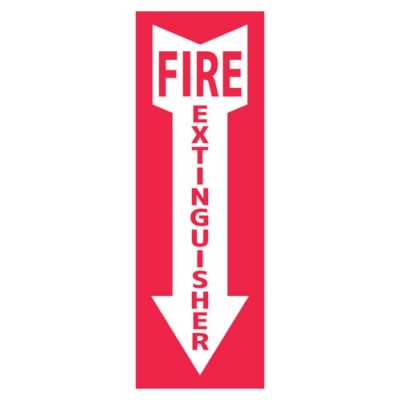Fire Prevention and Emergency Training:
Fire Extinguishers: State fire prevention regulations mandate that all buildings required by the fire department to provide portable fire extinguishers must install and maintain them in accordance with the National Fire Protection Agency’s (NFPA) Code 10. Specifically, fire extinguishers must be subjected to yearly maintenance. Each fire extinguisher must have a tag or label securely attached that indicates the month and year the maintenance was performed, the identification of the person and company performing the maintenance.
Each fire extinguisher must be inspected each month, with the employee signing and dating the rear of the service tag. The employee is ensuring the fire extinguisher:
- It remains in its designated place.
- They are accessible and visible.
- Operating instructions are legible and fully visible.
- Safety seals and tamper indicators are not broken or missing.
- The extinguisher feels full when lifted.
- The extinguisher is not physically damaged, corroded, leaking, or clogged.
- The pressure gauge reading or indicator is in the operable range or position.
Emergency Action Plan:
According to OSHA regulation 1910 Subpart E, employers with more than 10 employees must have both a written emergency action plan and a written fire prevention plan. Employers with 10 or fewer employees must still have emergency action and fire prevention plans, but they do not need to be in writing. This guarantees that your employees are clear on what they are and are not to do in case of a fire at your business.
29 CFR 1910.157 states that if your plans included the use of portable fire extinguishers be used by employees, all employees must receive annual training on fire extinguisher use and the hazards associated with fighting the fires. If your plan does not include use of fire extinguishers, you must make sure that your employees understand they should not attempt to fight a fire and should evacuate the building, and THEN dial 911 to call the fire department.
Storage of Flammable Substances:
Flammable storage Cabinets: OSHA requires that chemicals be stored properly in order to prevent accidents. Flammable liquids need to be stored separately from other types of chemicals, such as those that are corrosive or highly reactive. Shops should avoid storing flammable chemicals in direct sunlight or near heat sources. 29 CFR 1910.106 details the regulations regarding designated and approved fireproof cabinets:
- Flammable liquid storage areas need to be labeled clearly with “FLAMMABLE – KEEP FIRE AWAY”
- No more than 60 gallons of Category 1, 2, or 3 flammable liquids and no more than 120 gallons of Category 4 flammable liquids can be stored in a fireproof cabinet.
- Category 1 liquids have flashpoints below 73.4° F and boiling points at or below 95° F
- Category 2 liquids have flashpoints below 73.4° F and boiling points above 95° F
- Category 3 liquids have flashpoints at or above 73.4° F and at or below 140° F
- Category 4 liquids have flashpoints above 140° F and at or below 199.4° F
- Metal cabinets need to be constructed with at least 18-gauge sheet iron and double walled with 1 ½ inch air space and the doorsill must be at least 2 inches above the bottom of the cabinet.
- All containers stored in the cabinet need to be labeled properly with expiration dates, contents, and manufacturer warnings.
Flammable Liquids Storage Rooms: Shops that do painting likely have a paint storage or mixing room. These must comply with OSHA ventilation requirements. OSHA flammable storage regulations 29 CFR 1910.106 refer to the requirements for electrical wiring, storage capacity, and arrangement of the chemicals.
- Electrical wiring inside storage rooms used for Category 1 and 2 flammable liquids need to be approved under the specifications for Class I, Division 2 Hazardous Locations (29 CFR 1910.307 and 106).
- People need to be able to safely move in and out of the storage room.
- Under 1910.106(d)(5)(v), Table H-14 outlines on which floors flammable categories 1 through 4 may be stored.
- The storage room must be built in a way that contains spills if/when they occur, and workers should safely remove and appropriately manage leaking containers as soon as they are discovered.
- A fire extinguisher and/or other fire control device or system should be readily available in or near the room.
Worker Rights:
If workers are concerned about their safety, they have the right to contact their regional OSHA office to request advice or an inspection.
Reporting Injuries: Employers are responsible to investigate workplace injuries, determine whether or not they need to be reported to OSHA, and report those incidents.
Recent Posts
The U.S. Department of Labor Announces Proposed Rule To Protect Indoor, Outdoor Workers From Extreme Heat
The U.S. Department of Labor has proposed a new rule aimed at protecting workers from extreme heat hazards. This initiative seeks to safeguard approximately 36 [...]
Supreme Court Overturns Chevron Deference: What It Means for Workplace Safety and Regulation
The landscape of federal regulation is set for a seismic shift following a recent Supreme Court decision. On June 28, in Loper Bright Enterprises, et [...]
Navigating the Compliance Maze: How NARFA Simplifies Employee Benefits for Automotive and Trade Industries
In today's complex regulatory environment, businesses in the automotive, roads, fuel, and related industries face unprecedented challenges in managing employee benefits. Recent studies show that [...]




